

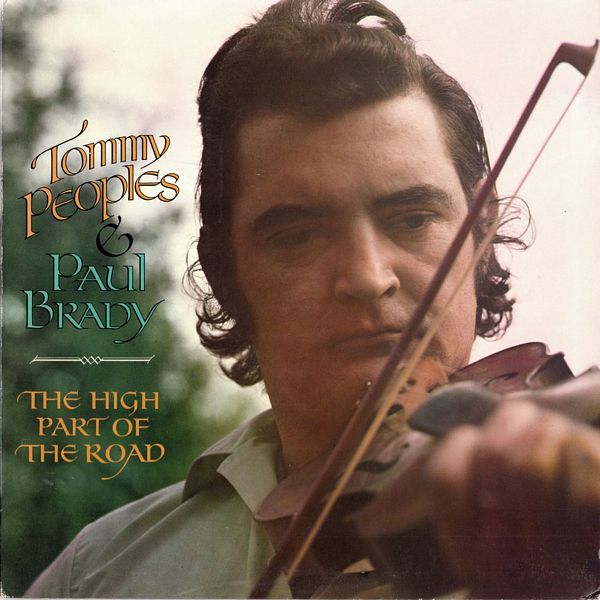 |
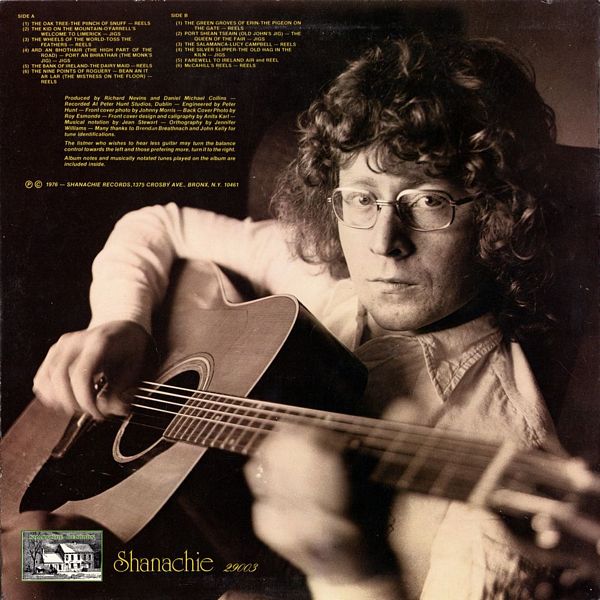
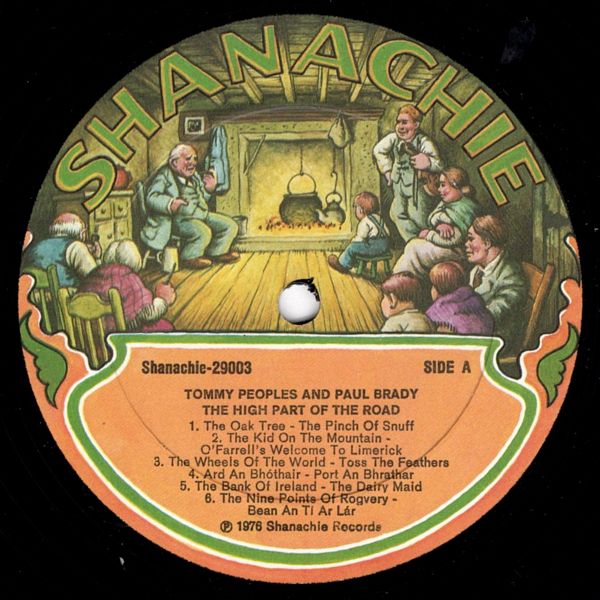
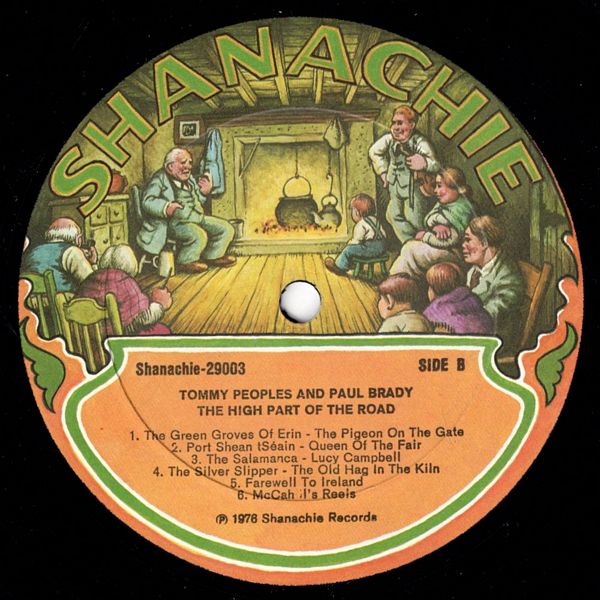 |

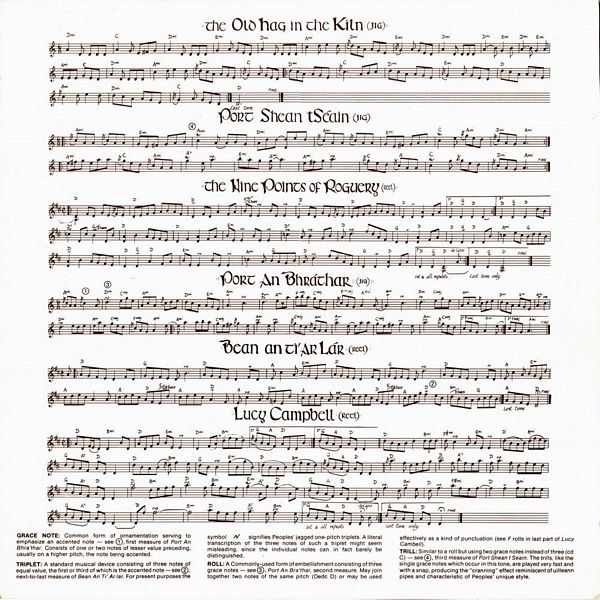 |
Sleeve Notes
In the world of Irish music, the name of Tommy Peoples is universally recognized as one of the finest fiddle players we are so lucky to have around nowadays. The existence of a select group of highly individualistic and very skilled players guarantees that, for the foreseeable future anyway, Irish music will continue to be played on the fiddle as well, if not better than, it has always been — that is music of the highest standard. And so, to lovers of Irish music, this album is not only a very welcome happening, but an important one also. And as most musicians are temperamental to some degree at least, Tommy being no exception, it is doubly fortunate that he is playing better music here than I have ever heard from him before; and when you're talking about Tommy Peoples that really is saying something.
Tommy, who is now in his late twenties, is from St. Johnstown, Co. Donegal, not far from the border with Northern Ireland and about 8 miles from Derry City, although his father is not a player, his family had music in it and Tommy learned to play from his first cousin Joe Cassidy. Donegal is the county in Ireland for fiddle playing and at one time (though sadly not nowadays) it is said that there was at least one fiddle in every house. The Donegal style of fiddle playing is unmistakable and one of its main characteristics is the use of short strokes of the bow, giving a sort of staccato quality to the music. A strong Scottish influence, both in the style and in the tunes played, can be seen too, for which Ulster's proximity to Scotland and the resultant cross-migration are responsible. Classic examples of this style can be found in the playing of the Doherty brothers — Micky (deceased) and Johnny, from Glenties and also the playing of the late Frank Cassidy from Teelin in the south-west of the county.
However, while Tommy's playing has undoubtedly many of the typical Donegal characteristics, it also has a lot more besides. He has done a lot of travelling around the country and consequently has played with more musicians than most of us have. He lives in Kilfenora, Co. Clare (where he is married with three children) which is the center of one of Ireland's most important musical strongholds. One cannot say for sure, but it is highly probable that his many contacts, with different musicians and styles of playing have a lot to do with his having a style all of his own which combines technical and inventive genius, feeling, and musical quality in such a perfect blend. In short, he is a superb musician.
Accompaniment in Irish music is considered by many to be a doubtful practice and this feeling is often expressed in the use of descriptions like "piano drivers," etc. However, this feeling does not usually arise from any point of principle but rather because so much good music is ruined by accompanists who simply have not got a clue — a case in point is the music of the great Sligo fiddler, Michael Coleman. Irish music might seem simple at first sight but in fact it is both subtle and complex, and for tasteful accompaniment requires both a knowledge of and feeling for the tunes to be played and a high degree of musical expertise. On this album Tommy is joined by a man who possesses all the necessary qualities in seemingly endless supply. Paul Brady, who is from Strabane, Co. Tyrone, seven miles up river from Tommy, is my idea of a musical genius and his guitar playing is almost too good to be true, he is a fine musician and singer in his own right, and as one of the several instruments he plays is the tin-whistle, he has the understanding of Irish dance music necessary to do full justice to Tommy's playing. On this album his guitar playing adds another dimension to music which is already extremely good.
When two musicians of this caliber get together, naturally, we can expect good music — all the more so with Tommy Peoples and Paul Brady. But on this album, they have produced something which is beyond all that — it exceeded all my expectations and I would be surprised if anyone else were to react otherwise. In other words, I think you'll find this music as I did — incredibly good.
Tommy starts off the album with two Donegal reels. The first one, "The Oak Tree," has three parts and in the first one you can hear double-stopping, that is playing two strings simultaneously giving a sort of droning effect — a device very common in (but by no means exclusive to) Donegal fiddling, which Tommy uses very well. He uses it many times on this album including the second reel, "The Pinch of Snuff." Seamus Ennis, the legendary uilleann piper tells a great story about the origin of this reel, centering around the failure of the fairies to abduct a bride on her wedding night — however that is a tale for another day — Tommy's playing tells its own story. "The Kid on The Mountain," and "O'Farrell's Welcome to Limerick" are two of the "big" jigs in Irish music. Tommy puts great feeling into them, and Paul's sensitivity and understanding are very apparent. The second, a slip jig also known as "An Phis Fhluich" is well suited to the uileann pipes, and in the fourth part pipers use a sort of stuttering roll on the bottom "D" note — known as "cranning." Tommy manages to "cran" on the fiddle — a specialty of his. "The Wheels of The World" has an unusual sound for Irish music and is possibly of Scottish origin. There are four distinct versions of "Toss the Feathers" — something common enough in Irish music. Tommy possesses a great ability to slide into notes and bend them, and he does so particularly well in this tune. "The Nine Points of Roguery" and "Bean An Ti Ar Lar" are Donegal reels associated with Johnny Doherty, the great fiddler from Glenties. He calls the first one also "The Black Mare of Fanad." Tommy uses all the tricks in them — double-stopping, "cranning," etc. Great work!
Tommy gets great punch into "The Green Groves of Erin" and "The Pigeon on The Gate," also called "The Flowers of Red Hill," "The Clogher Reel," and "Dan McCarthy's Fancy." It is worth remembering that the titles of tunes serve only as a means of identification and seldom bear any descriptive relation to the actual tunes they are attached to. "Salamanca" is the name of a city in Spain which housed a famous seminary which educated many Irish priests during the Penal Days in Ireland. "Lucy Campbell" is a four-part reel which is definitely of Scottish origin, it has a first cousin in Scotland called "Pretty Marion." These are two of the great reels. "The Silver Slipper" and "The Old Hag in The Kiln" are two piping jigs. The second is often called "Dinny Delaney's" after a great, long deceased, Galway piper of that name. You can hear Tommy "cranning" in both of these jigs. "Farewell to Ireland" is one of Tommy's favorites and it was he who arranged the air version of the first part. This reel is also of Scottish origin. The album winds up with two rarely played reels, "McCahills," that are full of character. Tommy probably got these from Danny Meehan, an excellent Donegal fiddler. Tommy and Paul finish as they started playing music which can only be described in superlative terms — surely an eye — opener — we have a lot to be grateful for.
Peter Brown Dublin, 1976
Raw power and poignant emotion are at the heart of Tommy Peoples' music — he fiddles masterfully, bending, twisting, shaking each note for all its expressive worth. He plays as he lives, with fierce need, with disconcerting tenderness and frailty, with reckless, impassioned abandon. With one and the same breath of music he tells the world to take a walk and then helplessly embraces it. It's this desperately provocative tandem of aggression and love that distinguishes his fiddling, that gives rise to its haunting sensuality.
There is no record without Brady. He understood — everything that Tommy's playing said, good close ties he has with life and death himself. He reinforces every nuance of melody and rhythm with perfectly complementary strength and sensitivity — in the self-same way he both attacks and caresses the music. These Peoples-Brady performances embody and reflect, with rare consequence, the stuff of which lives are made.
Tommy, this album is for the world to know you by. It's the most eloquent statement you could ever have made of all that you feel, of who you are. Tommy, this is the most beautiful record I've ever heard. Peace.
Richard (Nevins)